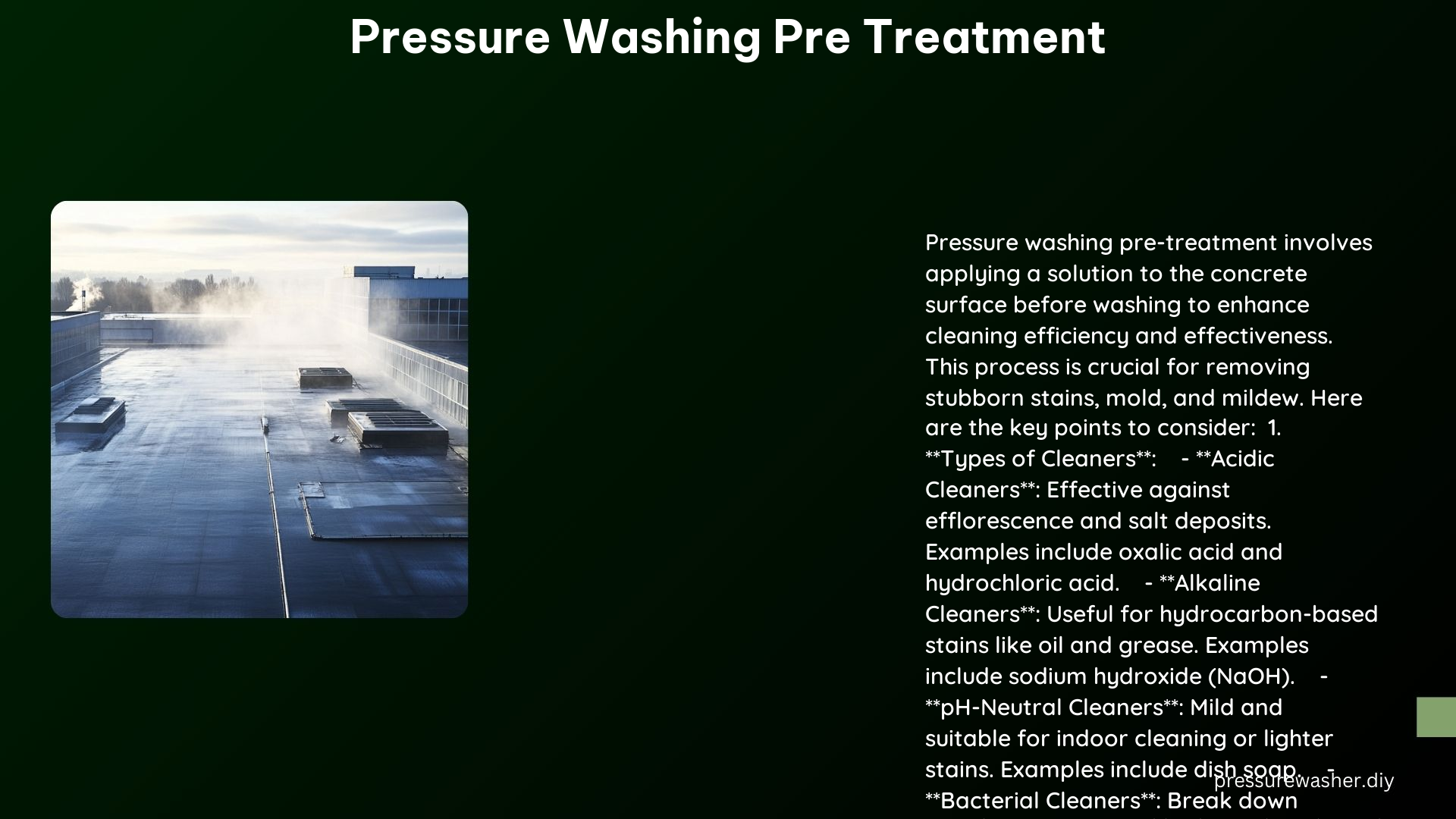Pressure washing pre-treatment is a crucial step in effectively cleaning concrete surfaces, ensuring a thorough and long-lasting clean. This comprehensive guide delves into the various types of cleaners, recommended dwell times, protecting surrounding vegetation, and the ideal ratio of bleach, soap, and water for optimal results.
Types of Cleaners for Pressure Washing Pre-Treatment
Acidic Cleaners
Acidic cleaners are heavy-duty mixtures that excel at removing stubborn stains, dirt, and contaminants that are soluble in acidic solutions. These cleaners are particularly effective against efflorescence, a common issue with concrete surfaces. However, it’s important to note that acidic cleaners require neutralization after use to prevent corrosion and damage to the concrete.
Alkaline Cleaners (Concrete Degreasers)
Alkaline cleaners, also known as concrete degreasers, are designed to tackle hydrocarbon-based stains, such as oil and grease. These high-pH cleaners break down oily substances, making the surface cleaning process much more efficient.
pH-Neutral Cleaners
For indoor use or lighter stains, pH-neutral cleaners are a milder option. These cleaners must be diluted with water according to the manufacturer’s instructions to achieve the desired cleaning power.
Bacterial Cleaners (Oxidation Cleaners)
Bacterial or oxidation cleaners utilize active enzymes to break down starch-, protein-, and hydrocarbon-based stains. These cleaners can be activated without the need for water, making them a versatile choice for various cleaning scenarios.
Recommended Dwell Time for Pretreatment Solution

The recommended dwell time for a pretreatment solution on a concrete driveway before pressure washing is typically 5-10 minutes. This allows the cleaning agents to penetrate and effectively break down the dirt, grime, and stains on the surface.
Protecting Surrounding Grass and Plants
To safeguard the surrounding grass and plants from the chemicals used in pretreatment, it’s essential to take the following precautions:
- Pre-wet the surrounding grass: Use a garden hose to thoroughly wet the areas around the driveway before applying the pretreatment solution. This helps reduce the likelihood of the grass absorbing the chemicals.
- Use a garden hose to rinse: If the pretreatment solution accidentally gets on the grass, immediately use a garden hose to soak the affected area and minimize any potential damage.
Ideal Ratio of Bleach, Soap, and Water
The ideal ratio for a pretreatment solution is:
– 0.6 gallons of liquid pool chlorine (3% bleach ratio)
– Fill the remaining with water
– Add 2 ounces of Dawn dish soap
This combination provides an effective cleaning solution that can tackle a wide range of stains and contaminants on concrete surfaces.
Technical Specifications
Bleach Concentration
For optimal cleaning results, a 3% bleach ratio is recommended. This concentration ensures the pretreatment solution has the necessary strength to break down and remove stubborn stains and dirt.
Downstream Injector
To achieve the desired concentration of the cleaning solution, it’s recommended to use a 10:1 or 5:1 downstream injector. This allows for precise control over the ratio of the pretreatment solution and water, ensuring consistent and effective application.
Surface Cleaner
The use of a surface cleaner is highly recommended, as it provides a more unified and faster clean compared to manual scrubbing or spot-treating. Surface cleaners can significantly improve the overall efficiency and effectiveness of the pressure washing process.
Additional Tips for Pressure Washing Pre-Treatment
- Pre-treating saves time: Applying a pretreatment solution before pressure washing makes the cleaning process easier and more effective, especially for stubborn stains and heavily soiled surfaces.
- Post-treating: After the pressure washing is complete, consider applying a post-treatment solution to the concrete surface. This can help brighten the appearance and kill any remaining bacteria or microorganisms.
- Safety Precautions: Always wear protective gloves and goggles during the pressure washing and pretreatment process to safeguard your eyes and skin from the chemicals and high-pressure water.
By following these comprehensive guidelines, you can ensure a thorough and efficient pressure washing experience, delivering exceptional results for your concrete surfaces.
References
- The Driveway Company. (n.d.). What To Spray on Concrete Before Pressure Washing. Retrieved from https://thedrivewaycompany.com/what-to-spray-on-concrete-before-pressure-washing/
- Reddit. (2021). When pre-treating the cement before cleaning. Does anyone know. Retrieved from https://www.reddit.com/r/pressurewashing/comments/rjp3u4/when_pretreating_the_cement_before_cleaning_does/
- Pro Power Wash. (2015). Chemicals on driveway, pre-treat/post-treat? Retrieved from https://propowerwash.com/board/upload/threads/chemicals-on-driveway-pre-treat-post-treat.32859/
- First Choice Exterior Cleaning. (2020). Pre-Treating Concrete Before Cleaning Your Driveway. Retrieved from https://www.firstchoiceexteriorcleaning.com/2020/04/17/how-pre-post-treating-helps-with-driveway-cleaning/
- 15 Cent Pressure Washing. (2023). Pre treating before pressure washing – YouTube. Retrieved from https://www.youtube.com/watch?v=jZGST54Zyqg
